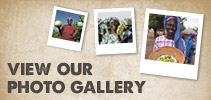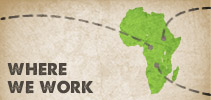Success stories
Building community structures in Darfur
North Darfur, Sudan, is an area affected by drought and conflict and more often associated with humanitarian aid than long term development processes. However, since 1998, communities have been mobilising to reduce their vulnerability and increase their self-reliance.
Conservation agriculture in Zimbabwe
In the Matopo area of Matabeleland South, Zimbabwe, the adoption of conservation agriculture techniques is helping farmers to increase their yields and conserve natural resources. This approach focuses on building farmers' knowledge and skills, using resources they have available and inputs that can be obtained locally.
Developing markets for local food varieties in Uganda and Kenya
Cassava is a staple food crop across much of East Africa, and is especially important to provide food during the 'hungry season'. In the Nakasongola District of Uganda, local varieties had been so badly affected by the combination of drought and Cassava Mosaic Virus (CMV) that the region had become a perennial recipient of emergency food aid.
Improving quality seed supply - developing viable community seed businesses
Limited availability of good quality seed is a key constraint repeatedly identified by farmers in rural areas in many countries. Open-pollinated seed varieties are in decline in favour of hybrids, which are often less suited to local conditions.
Paravets in Kenya
In Samburu district, northern Kenya, the training of community-based animal health workers has helped to fill a huge gap in extension services and enabled more people to access vital information and services to protect their livestock.
The Lead Farmer Programme in Malawi
In 2002, FAIR supported MZADD in a compost-making competition, which targeted some 200,000 farmers in three districts. In the first year of the competition, over 120,000 compost heaps were made. This was to be superseded in the following year, by a record-breaking 1.2 million compost heaps.
The ‘One Cow Per Poor Family’ programme in Rwanda
Livestock is a productive asset on the farm, playing an important role in providing protein and income from the production and sale of milk, meat, eggs and offspring. Manure can be utilised through composting as a very cost-effective fertiliser and soil conditioner, revitalising soil quality, fertility and its water retention capacity. Livestock ‘assets’ are also often seen as ‘walking banks’ to be sold in times of financial crisis to fund health care and education costs in particular. The following case study shows how increased access to livestock increases the capacity of smallholder farmers to generate food and income.
Transforming livestock markets in Zimbabwe
In Guruve district in northern Zimbabwe, a Participatory Market System Development (PMSD) approach is transforming the livelihoods of marginalised livestock farmers.
In 2005, local farmers, buyers, suppliers of inputs and services, community-based organisations, and relevant government departments were brought together in a series of participatory market mapping workshops, to identify key opportunities and constraints in the livestock market chain.
Women farmer groups in Liberia
In 2006, Liberia’s first ‘Women for Development’ group was formed by 17 people (13 marginalised women and four men) looking to rebuild their lives after the civil war. Members were provided with cutlasses, wheelbarrows, watering cans and other tools, as well as pineapple and cassava sticks to plant. The group was also provided with some money which members used to buy peanuts and beans. They planted these in a shared community garden and took turns to tend to this larger plot, as well as defining their own workplan, constitution and training needs.



